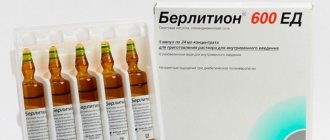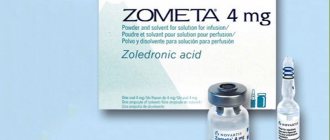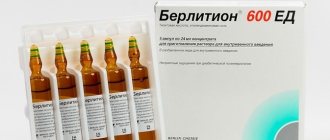Pharmacological properties of the drug Zovirax
Acyclovir is an antiviral drug that has high in vitro against herpes simplex virus types I and II. The toxic effect on the cells of the host body is minimal. Once in cells infected with the herpes virus, acyclovir is phosphorylated to form the active compound, acyclovir triphosphate. The first step of this process depends on the presence of virus-encoded thymidine kinase. Acyclovir triphosphate acts as an inhibitor and substrate for viral DNA polymerase, preventing further synthesis of viral DNA without affecting normal cellular processes. Pharmacokinetic studies have shown a minimal level of systemic absorption of acyclovir after repeated topical application of Zovirax cream.
Interactions with other medicinal drugs and other types of interactions
No clinically important interactions between acyclovir and other drugs have been identified.
Acyclovir primarily appears in the unchanged form of tubular secretion, so drugs that have a similar mechanism of vision can increase the concentration of acyclovir in plasma.
Probenecid and cimetidine will increase the period of administration of acyclovir and increase the area under the concentration/hour curve, but in view of the wide therapeutic index of acyclovir, dose adjustment is not necessary.
In patients who are simultaneously treated with Zovirax for intravenous administration and other drugs that may have a similar mechanism of detection, there may be a potential increase in plasma concentrations of one or both drugs or their metabolites Itiv. When acyclovir is ingested for one hour with an immunosuppressant, which is used in the treatment of patients after organ transplantation - mycophenolate mofetil - the level of acyclovir and the inactive metabolite mofetil also increases in the plasma mycophenolate.
During chronic treatment with a high dose of intravenous acyclovir, it is necessary to carefully control the concentration of lithium in the blood serum due to the risk of toxicity. Care (with control of the function of drugs) is also required when Zovirax is prescribed for intravenous administration with drugs that affect the function of drugs (such as cyclosporine, tacrolimus).
Experimental studies in five subjects indicate that concomitant therapy with acyclovir increased the AUC of administered theophylline by approximately 50%. It is recommended to moderate the plasma concentration during one-hour therapy with acyclovir.
Use of the drug Zovirax
The drug is intended for external use only. For children over 12 years of age and adults, Zovirax cream should be applied 5 times a day at approximately 4-hour intervals, except at night. It is important to begin treatment as quickly as possible at the onset of infection, preferably during the prodrome. Treatment should last at least 4 days. If healing does not occur, treatment can be continued for up to 10 days. If the symptoms of the disease do not disappear after 10 days of treatment, the patient should consult a doctor.
Features of good stagnation
Adequate hydration must be maintained in patients using either intravenous acyclovir or high doses of oral acyclovir.
Internal doses of traces are administered by infusion over a period of one year to eliminate the sedimentation of acyclovir in the solution. It is necessary to avoid liquid or bolus injections.
The risk of injury increases with the administration of other nephrotoxic drugs. It is necessary to take medication when taking acyclovir orally concomitantly with other nephrotoxic drugs.
Patients with nitric deficiency and summer age patients
Acyclovir is excreted from the body primarily due to nicotine clearance, so if you suffer from nicotine deficiency, change the dose (chapter “Dosage and method of congestion”). In summer-aged patients, there is also a high risk of impaired narcotic function, so for this group of patients it is also possible to change the dose. Illnesses in these groups (illnesses with nicotine deficiency and summer age diseases) are also at risk of neurological side reactions and therefore must be under close supervision. In summary, such reactions are often negative when treated with the drug (section “Adverse reactions”).
Trival or repeated courses of acyclovir treatment in individuals with a weakened immune system may lead to the appearance of viral strains with reduced sensitivity, which may not be consistent with the trial of acyclovir treatment.
In patients who need to take high doses of the drug internally, for example, for the treatment of herpetic encephalitis, take into account the signs of nitric function, especially in cases of dehydration or evidence of nitric deficiency.
Dilutions of Zovirax for internal infusion have a pH of approximately 11.0 and should not be administered orally. The drug contains sodium (26 mg, approximately 1.13 mmol). This is taken into account by patients who are on a sodium-controlled diet.
Side effects of the drug Zovirax
Some patients may experience temporary, rapidly passing sharp or burning pain when using Zovirax cream. Approximately 5% of patients experienced mild dryness and flaking of the skin. A small proportion of patients reported redness (erythema) and itching. Very rarely, cases of contact dermatitis have been reported following the use of the cream. In susceptibility testing, these cases were more likely to be associated with the components of the cream base rather than with acyclovir. There are isolated reports of immediate hypersensitivity reactions, including angioedema, due to topical use of acyclovir. Necessary safety precautions for use . Accidental contact of the cream with the eyes should be avoided. Patients with herpes labialis should be cautioned against contact transmission of the virus to others, especially if there are open lesions.
Showing
Treatment of infections caused by the herpes simplex virus in patients with immunodeficiency and severe genital herpes in patients without immunodeficiency.
Prevention of infections caused by the herpes simplex virus in patients with immunodeficiency.
Treatment of infections caused by the Varicella zoster
.
Treatment of herpetic encephalitis.
Treatment of infections caused by the herpes simplex virus in newborns and does not last up to 3 months.
Special instructions for the use of Zovirax
Zovirax cream should only be used to treat herpes on the lips and face. It is not recommended to apply Zovirax cream to the mucous membranes of the mouth, eyes, or use it to treat genital herpes. Persons with particularly severe manifestations of Herpes labialis need to consult a doctor. Zovirax cream is not recommended for use in patients with immunodeficiency. Such persons need to consult a doctor regarding treatment of any infection. Use during pregnancy or breastfeeding. Women during pregnancy and breastfeeding are recommended to use the drug only when the benefit to the mother outweighs the potential risk. Children. There is insufficient data regarding the safety of the drug in children under 12 years of age, therefore it is recommended to use the drug in children over 12 years of age. The ability to influence the reaction rate when driving a vehicle or working with other mechanisms. No data.
Zovirax manufacturer's instructions
Compound
active ingredient:
acyclovir; 1 g (g) of cream contains 50 mg (mg) of acyclovir;
Excipients
: propylene glycol, white soft paraffin, mineral oil, cetostearyl alcohol, Arlacel 165, poloxamer, sodium lauryl sulfate, dimethicone, purified water.
Dosage form
Cream.
Basic physical and chemical properties
: cream from white to whitish in color, homogeneous, without grains, lumps and foreign inclusions, without signs of separation.
Pharmacotherapeutic group
Antiviral agents. Acyclovir. ATC code D06B B03.
Pharmacodynamics
Acyclovir is an antiviral drug that has in vitro activity against herpes simplex virus types I and II. The toxic effect on the cells of the host body is minimal. When acyclovir enters cells infected with the herpes virus, it is phosphorylated to form the active compound, acyclovir triphosphate. The first step of this process depends on the presence of virus-encoded thymidine kinase. Acyclovir triphosphate acts as an inhibitor and substrate for viral DNA polymerase, preventing the synthesis of viral DNA without affecting normal cellular processes.
Pharmacokinetics
Pharmacokinetic studies have shown minimal systemic absorption of acyclovir following repeated topical application of the cream.
Indications
Treatment of infections of the lips and face caused by the herpes simplex virus (Herpes labialis).
Contraindications
Hypersensitivity to acyclovir, valacyclovir, propylene glycol or other components of the cream.
Interaction with other drugs and other types of interactions
No interaction detected.
Features of application
The cream should only be used to treat herpes on the lips and face. It is not recommended to apply the cream to mucous membranes, such as the mouth or eyes, and should not be used to treat genital herpes. Accidental contact of the cream with the eyes should be avoided.
Persons suffering from particularly severe and repeated manifestations of Herpes labialis require consultation with a doctor. Persons with herpes should be warned against contact transmission of the virus to other people, especially if there are open lesions (for example, they should wash their hands before and after using the cream). It is not recommended for use by persons with immunodeficiency. Such persons need to consult a doctor for treatment of any infection.
This medicine contains propylene glycol, which may cause skin irritation, and cetostearyl alcohol, which may cause local skin reactions (eg contact dermatitis).
The ability to influence reaction speed when driving a vehicle or operating machinery
No data.
Use during pregnancy or breastfeeding
For pregnant and breastfeeding women, the drug is recommended to be used only when the benefit, in the opinion of the doctor, outweighs the risk. However, it should be understood that the systemic penetration of acyclovir after external application of the cream is very low.
Clinical studies have shown that the use of acyclovir in drugs of any composition does not lead to an increase in fetal development defects.
Some clinical data indicate that acyclovir passes into breast milk when administered internally. However, the amount of acyclovir that can enter the baby's body during breastfeeding after applying this drug in the form of a cream is insignificant.
Clinical studies have shown that acyclovir, after oral administration, has no clinically significant effect on male fertility. There are no data on the effect of acyclovir on women's fertility.
Directions for use and doses
The drug is intended for external use.
Adults and children over 12 years old
The cream should be applied 5 times a day at approximately 4-hour intervals, with the exception of night time. It is important to begin treatment as quickly as possible at the onset of infection, preferably during the prodrome or erythema stage. You can start treatment in the later stages - papules or bubbles.
Treatment lasts at least 4 days. If healing does not occur, treatment can be continued for up to 10 days. If the symptoms of the disease do not disappear after 10 days of treatment, the patient should consult a doctor. You should wash your hands before and after using the cream, and avoid excessive rubbing or touching the affected areas with a towel to prevent aggravation or transmission of infection.
Children
There is insufficient data on the safety of the drug in children under 12 years of age, so it is recommended for use in children over 12 years of age.
Overdose
Adverse drug effects following oral or topical administration of the entire contents of a tube of cream are not expected due to minimal systemic exposure. If you suspect an overdose, seek medical help.
Adverse reactions
Skin and connective tissue disorders: rare
: (≥ 1/1000; <1/100): temporary sharp or burning pain after applying the cream, moderate drying and flaking of the skin, itching;
single:
(≥ 1/10000; <1/1000): erythema, contact dermatitis after application of the cream (sensitivity testing showed that these cases were most often associated with the components of the cream base, and not with acyclovir).
From the immune system
:
rare
: (< 1/10000): immediate hypersensitivity reactions including angioedema and urticaria.
Best before date
3 years.
Storage conditions
Store at a temperature not exceeding 25 °C out of the reach of children. Do not freeze.
Package
2 g of cream in an aluminum foil tube with a plastic screw cap. 1 tube in a cardboard box.
Vacation category
Over the counter.
Manufacturer
Glaxo Operations UK Limited.
Manufacturer's location and address of place of business
Harmire Road, Barnard Castle, Durham, DL12 8DT, UK/Harmire Road, Barnard Castle, Durham, DL12 8DT, UK.
© Translation into Russian by the editorial team of apteka24.ua.
Source: “State register of medicinal facilities of Ukraine”, 2020.
Method of congestion and dosage
Follow with continuous internal infusion for at least 1 year.
The course of treatment with Zovirax for internal administration usually lasts 5 days, but changes may be made depending on the patient's response to therapy. Treatment for herpetic encephalitis lasts for 10 days. Treatment of infection in newborns caused by the herpes simplex virus lasts for 14 days for lesions of the skin and mucous membranes and 21 days for dissemination and damage to the central nervous system.
The benefit of prophylactic administration of Zovirax for intravenous administration is determined by the risk of infection during the period.
For the treatment of infections caused by the herpes simplex virus (including herpes encephalitis) or the Varicella zoster
, Zovirax for internal administration must be administered at a dose of 5 mg/kg body weight skin for 8 years for the normal function of the skin.
For the treatment of infections caused by the Varicella zoster
In patients with immunodeficiency or patients with herpetic encephalitis, Zovirax for intravenous administration should be prescribed at a dose of 10 mg/kg body weight skin for 8 years for normal functioning of the skin.
Patients who are obese should be given a dose based on their ideal body weight, not their actual body weight.
Children
Doses for children from 3 months to 12 years of age are administered per body surface area.
For the treatment of infections caused by the herpes simplex virus (including herpes encephalitis) or the Varicella zoster
, Zovirax for intravenous administration is prescribed at a dose of 250 mg/m2 of the body surface of the skin for 8 years for the normal functioning of the skin.
For the treatment of infections caused by the Varicella zoster
, in children with immunodeficiency or herpetic encephalitis, Zovirax for internal administration is prescribed at a dose of 500 mg/m2 of the body surface of the skin for 8 years for the normal function of the skin.
The dose of Zovirax for intravenous administration to newborns and infants up to 3 months is based on the infant's body weight.
Recommendations: treatment regimen for newborns and not to be kept alive for up to 3 months with infection caused by the herpes simplex virus, 20 mg/kg/skin body weight for 8 years for 21 days with a degenerative form and hurray women of the central nervous system or 14 days if sick, between the skin and mucous membranes.
For children and cats with impaired function, the dose should be modified according to the level of impairment of this function (advancement of nitric deficiency illnesses).
Ailments of the summer century
The mother is aware of the possibility of impaired function of nircosis in patients of late age, and the dose of the drug needs to be changed accordingly (monitoring illnesses due to nitric deficiency). Maintain an adequate level of hydration to the body.
Ailments due to nirkov deficiency
Zovirax must be administered internally with care to treat patients with nitric deficiency. Maintain an adequate level of hydration to the body.
Low-level changes in dosage must be made consistently to monitor creatinine clearance.
Adults:
| Creatinine clearance | Recommended dosage |
| 25 – 50 ml/xv | 5-10 mg/kg body weight skin 12 years |
| 10 – 25 ml/xv | 5-10 mg/kg body fat skin 24 years |
| 0 (anuria) – 10 ml/xv | For patients undergoing continuous ambulatory peritoneal dialysis or hemodialysis, 2.5-5 mg/kg skin for 24 years and after the hemodialysis session |
Children:
| Creatinine clearance | Recommended dosage |
| 25 – 50 ml/xv/1.73 m2 | 250-500 mg/kg/m2 body surface or 20 mg/kg skin body mass for 12 years |
| 10 – 25 ml/xv/1.73 m2 | 250-500 mg/kg/m2 body surface or 20 mg/kg skin body weight 24 years |
| 0 (anuria) – 10 ml/xv/1.73 m2 | For patients undergoing continuous ambulatory peritoneal dialysis or hemodialysis, 125-250 mg/kg/m2 body surface area or 10 mg/kg skin body weight for 24 years and after a hemodialysis session |
Method of administration
The required dose of Zovirax should be administered by continuous internal infusion over a period of at least 1 year, regardless of the dose being administered.
A bottle of Zovirax for internal administration must be filled with the appropriate volume of water for injection or 0.9% sodium chloride for injection. To maintain the dose, 1 ml of it will be mixed with 25 mg of acyclovir, 250 mg of the drug will be mixed with 10 ml of acid.
After adding the liquid, lightly shake the bottle until it is completely broken.
To prepare the solution for internal administration of preparations as indicated in the product, the solution was diluted to a concentration of no more than 5 mg/ml (0.5%): the solution was dissolved after dilution of 250 mg of acyclovir in 10 ml of water for injection. ( or 0.9% sodium chloride), added to the required dose for infusion, whichever is indicated below.
For children, if it is necessary to reduce to a minimum the volume of liquid to be administered, it is recommended that 4 ml of diluted solution (100 mg acyclovir) be added to 20 ml of liquid for infusion.
For adult recommendations, the volume of infusion should be no less than 100 ml, as long as the concentration of acyclovir is lower than 0.5%. Therefore, 100 ml of liquid for infusion is required for administration of Zovirax in doses of 250 mg and 500 mg (10 or 20 ml of diluted dose). If it is necessary to administer larger doses of the drug (500 – 1000 mg of acyclovir), the volume of infusion for infusion must be increased to 200 ml.
After administration as recommended above, Zovirax for internal administration is suitable for use at low concentrations for the preparation of infusions and remains stable for 12 years at room temperature (15 °C-25 °C C):
- 0.45% or 0.9% sodium chloride;
- 0.18% sodium chloride and 4% glucose;
- 0.45% sodium chloride and 2.5% glucose;
- rozchin Hartman.
When preparing devices for internal infusion, as indicated by the drug, the concentration of acyclovir is maintained at no more than 0.5%.
Due to the fact that Zovirax for intravenous administration does not contain any antimicrobial preservatives, the preparation and dilution of the drug must be carried out in aseptic tanks immediately before curing, non-vicoristan lattices, and disposing of the traces.
If there is turbidity or crystallization, such problems are unsuitable for stagnation and disappear.
Suspension during pregnancy or breastfeeding
Information about injecting acyclovir into women's fertility every day. In a follow-up study of 20 human patients with normal sperm counts, oral administration at a dose of up to 1 g over a period of six months did not show clinically significant swelling on the pelvis. spermatozoa, motility or morphology.
The post-registration registry has documented the results of the administration of various pharmaceutical forms of Zovirax to patients. There was no increase in the number of congenital birth defects in children whose mothers were treated with Zovirax during pregnancy compared with the general population. However, it is only necessary to use Zovirax for infusion in cases where the potential risk for the mother from taking the drug outweighs the possible risk for the fetus.
When administered orally 200 mg of acyclovir 5 times per dose, acyclovir passes into breast milk in concentrations that become 0.6-4.1 equal to acyclovir in blood plasma. Children who feed on this milk can potentially take acyclovir at a dose of up to 0.3 mg/kg body weight per dose. It is necessary to administer acyclovir with caution to women who are breastfeeding, in order to maintain the reproductive system/measles of the baby.
This is due to the fluidity of the reaction during treatment with vehicles or other mechanisms.
Zovirax for internal administration is intended to be used for the treatment of patients who are in a stationary hospital, so information about the infusion of the keratin by car and other mechanisms is not necessary. hidden. The use of Zovirax infusion by car or other mechanisms has not been monitored.







